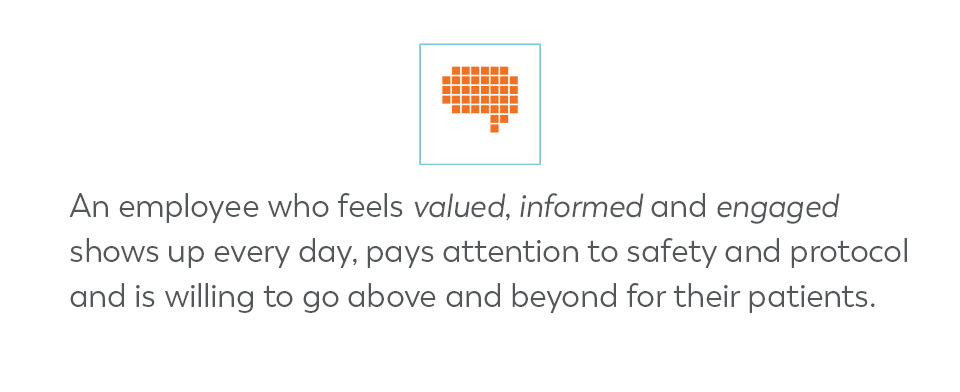Employee Communications Boost Engagement and Productivity
The devastation caused by COVID-19 has reached into all of our lives and all of our facilities.
With vaccines slowly being rolled out, there’s an end in sight, but our lives have all been indelibly changed. The crisis taxed our facilities, our staff and our administrators. It required us to communicate internally and externally in different ways, with more urgency and with more severe consequences.
We learn from crises. And after each one, we should take the time to assess what we did differently in the crisis, and how or what we should maintain going forward. Most leaders in skilled nursing and hospice facilities helped their staffs understand the fast-moving changes brought on by the pandemic through strengthened internal communications – townhalls, staff huddles, direct communications. What should communications look like after the pandemic fades?
The answer is: They should not change. Communicating with employees is a fundamental component of employee engagement. Corporations learned years ago that employee engagement improves productivity and profitability. A recent Gallup poll of small businesses showed that just over one in three employees are engaged at work. That leaves two-thirds who are actively disengaged or have no attachment to their workplace. In a high-touch service business like healthcare, disengaged or unengaged employees can lead to mistakes, safety hazards and rampant turnover.
With two-way communication, a focus on an inclusive work culture, and development and training opportunities, employees feel valued and behave accordingly. The CNAs in the skilled nursing facilities and the hospice workers in the patient’s home are the face of your organization. The experience they give your clients is your brand and your future. A helpful, considerate employee who provides care and support to other people’s loved ones is the service you provide and is directly linked with your reputation.
 It is important to provide consistent internal communications to your teams. Think of communications as a tool to meet your business goals. Communication is not about sharing information; it is about influencing behavior. Sharing information may be a part of that, but ask yourself what you want employees to do. And what do they need to know to be able to do that? Engagement is about enabling your workforce to perform effectively.
It is important to provide consistent internal communications to your teams. Think of communications as a tool to meet your business goals. Communication is not about sharing information; it is about influencing behavior. Sharing information may be a part of that, but ask yourself what you want employees to do. And what do they need to know to be able to do that? Engagement is about enabling your workforce to perform effectively.
Employee communication is best enabled through a variety of forums. Regular townhalls where senior leaders speak directly to all employees and provide an opportunity to ask questions are crucial. Varying the times of these meetings from month to month to target different shifts sends the message that you are trying to encourage participation.
It may help to have your leadership team follow up on townhalls with their own team meetings, where they share the messaging from the townhall, as well as messages specific to their functions.
Having regular written communications ensures that you control the message and establish yourself as the trustworthy source. In the absence of regular communication from senior leadership, rumors can take over. Your communications could be a weekly email in a simple format or a monthly newsletter, and daily bulletins for more urgent needs. Focus more on relevant content and less on format and fonts. If not all employees are online, ensure that printed versions of the information are made available to all.
Create an internal communications hub on your intranet if you have one, or on a password protected section of your website. Information shared in townhalls, huddles or written communications can be housed there for all employees to find. It helps establish a source of truth and offers a place for employees to check information.
Investing in leadership and communications training for your senior staff, especially those who oversee your front-line workers, may be beneficial. Managers often overestimate their communication abilities. I worked in a global manufacturing company once where we invested time and energy into building the communications effectiveness of plant managers. Why? In a survey of more than 80 plant managers around the world, we found that managers rated their own communications effectiveness higher than did their subordinates, every single time. Often, this has to do with the ability of the manager to ensure that what they are communicating is actually being understood and operationalized. Are they assessing whether communications are effectively influencing behavior or “just talking”?
To sum it up:
- Establish regular communication mechanisms, both written and oral.
- Create an environment where leadership owns the messaging.
- Create engaged employees through communication and help emphasize their value.
- Use communication to achieve business goals and change behaviors.
Internal communications are one of the least expensive business tools you have at your disposal. A small amount of effort to communicate openly and frequently helps create an environment where employees, including managers, feel engaged.
If you have discovered a communication practice during the pandemic that has been particularly helpful, we’d love to hear about it! We’re planning a future blog post about effective internal communication practices and would like to feature one of your success stories. And if you would like help in implementing more effective internal messaging and communication tools, contact Stephanie Johnston at stephanie@transcend-strategy.com.










